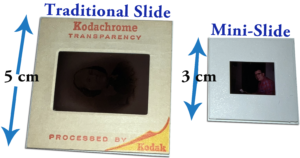
There We have all seen the traditional 35mm color slide transparency format of photographs. An example of these is shown here compared with the mini-slide. The mini-slide never gained a foothold in the consumer photo industry and thus, in our multi-decade time of service, have only seen this formant once. Yet, properly used by the consumer, this format was capable of fantastic imaging, though understandably not as good as 35mm. Kodachrome lever lets you down. Its dynamic range excedes that of digital and, properly exposed, has detail exceding 12k photography.
In the illustration, it is shown how the packaging was accomplished. The slides arrived from the processing lab tightly packed in a cardboard box. Inside the box there was a retaining clip used to hold the slides. This was important because it was critical to be able to handle the slides without fumbling. The retaining clip guaranteed getting them out of the box in an orderly manner.
Once out of the box, the slides could then be simply slid out of the retaining clip and mounted in some sort of display mechanism for the projection (not shown).
It is understandable why it never took root. The obvious limitation was the size and therefore a limited resolution relative to 35mm film. The other very great limitation is what we at W. Cardone Productions have to live with, which no doubt was experienced by those actually using this format. The means to display the images was extremely limited. Our problem is that there are no holders available for scanning and thus we have to carefully tune the scanning focus to be able to get the sharp images that are possible. We are talking labor, folks. That forces us to up the fee for duplicating these mini-slides to digital.
